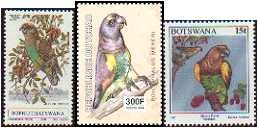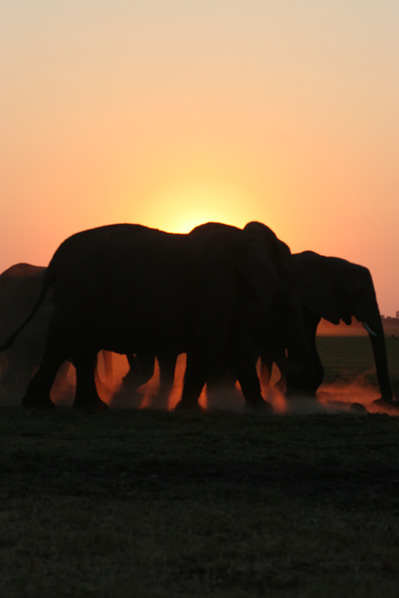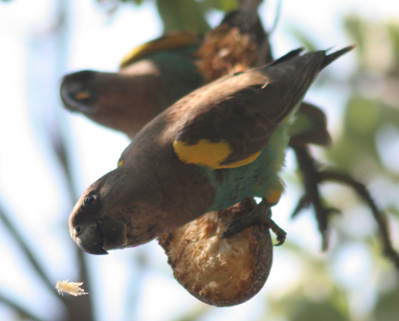Though almost entirely circumstantial and coincidental, there are some striking commonalities between African elephants and Meyer's Parrots...
Two striking qualities of the Okavango Delta are that this massive system of islands, floodplains, and meandering channels, is home to the largest populations of African elephants and Meyer's Parrots in the world. There are now estimated to be anywhere between 120 000 and 150 000 elephants in northern Botswana, of which approximately 50 000 seasonally frequent the Okavango Delta. Similarly, the sighting frequency of Meyer's Parrots in the Okavango is the highest I have recorded on my travels to protected within their range in southern, central and eastern Africa. Unfortunately, in most areas sightings were limited to one or two parrots every three days, between 10 and 30 times less than the Okavango.
During the 2007 field season of the Meyer's Parrot Project we spent March and April exploring and mapping our study area in the Okavango Delta, on foot. We spent five hours every morning out in the bush, and had the privilege of walking a wilderness area home to leopard, lion, elephant, and buffalo. We maintained very close tabs on our resident male lions and their associated pride, which visited once a week to hunt and mate. Our initial plan was to walk a sequence of sections along an outlet of Kubu Lagoon, the most significant body of water in the study area. Aerial photographs, however, revealed large, unexplored (at least recently), islands and lagoons, and on foot we found a veritable maze of small islands, salt pans and lagoons. On these islands, we found some amazing Baobab trees, large groves of Leadwood, and beautiful islands of Wild Date palms and Marula trees along the main channel. A wonderland, into which we departed eagerly every morning, anticipating the discovery of another beautiful scene or spiritual encounter with an elephant, lion, warthog or Meyer's Parrot. It was on these walks that we began to notice direct and coincidental links between Meyer's Parrots and African elephants.
Early in March each year, Meyer's Parrots begin courtship and nest preparation in the Okavango Delta, and thus all active breeding pairs can be found announcing ownership of their breeding territories comprising up to 5 nest cavities. On the walks, we followed and located as many "dueting" couples as possible, in order to GPS mark nest cavities for subsequent inspection for breeding activity. Often, what we found was a single male, managing to achieve the "dueting" effect by himself. This seemed to be very attractive, as subsequent visits to the nest cavity revealed that he either had a partner or found one as a result. Active nest discovered during these walks formed the basis of the Meyer's Parrot Nesting Project, which was launched that season, whereby we monitored nesting activity during 10-hour nest observations. In total, we recorded over 1300 hours of observations.
Just as the Meyer's Parrots got into the swing of things, the elephants began migrating towards the Okavango Delta as the pans up north began to dry up. In late March, walking became more hazardous due to the arrival of the first wave of the migration. The breeding herds pouring into the area at this time were all haggard after daily 30 - 40 mile hikes through dry Mopane woodland between seasonal pans for the last few weeks. These elephants were, needless to say, very irritable and positively ravenous. Often the focus of their feeding activity was the sugar-rich cambium under the bark of Knobthorn Acacia trees, resulting in large section of living vascular tissue and bark being stripped off and part of the canopy or entire tree dying. In a similar fashion, elephants seemed to disturbed Mopane trees as much as possible too. Males elephants seemed to focus on pushing entire trees down to browse the canopy - it is estimated that a large bull pushes over 1500 trees a year. Females, on the other hand, are lot more gentle, and typically disturb the Mopane tree as much as possible without killing it. In so doing, they stunt the growth of these tough Mopane trees, thus creating vast areas of scrub Mopane woodland that has the appearance of stands of fruit trees or vineyards. African folklore, says that female elephants do this to ensure that the leaves of Mopane tree are available to their offspring. This makes sense, as Mopane leaves have the highest protein content of any tree in the African savanna analyzed thus far. Anyway, elephants cause a lot of damage when they return to the delta. They repeat this migration every year, as they are dependent on the winter floodwaters to sustain them through the dry season. This establishes a distinct migration route utilized by the same breeding herds each year, and engineers both Mopane woodlands and Acacia-Combretum marginal woodland flush with snags, dead branches and the resultant nest cavities. Second and third waves came in early and late April, during which we witnessed literally thousands of elephants move through our study area in aggregations of several breeding herds, including up to 50 elephants of different ages.
During 2007, the Meyer's Parrot Nesting Project yielded nest cavity characteristics for over 40 active nest cavities. An analysis of these nest cavities revealed that over 80% of nest cavities resulted directly from elephant disturbance to Mopane, Leadwood or Knobthorn Acacia trees. In addition, when projected onto an aerial photograph, Meyer's Parrot nest cavities were clustered along the elephant migration path that followed the edge of Kubu Lagoon. Therefore, African elephants play a significant role in the nesting ecology of the Meyer's Parrots. Whether or not Meyer's Parrots are as dependent on tree disturbance by African elephants in other areas requires further investigation. Nevertheless, subsequent investigation of any other connections between these two iconic species revealed the following story.

Meyer’s Parrot stamps from around Africa
A study of elephant dung in the Kalahari revealed that African Ebony fruit, Marula fruit, False Mopane pods and Sycomore figs frequently appeared in the diet of African elephants. In our study, we attempted to measure the relative impact of Meyer's Parrots on pollination and seed dispersal of 25 tree species in the Okavango Delta. This revealed that Meyer's Parrots dispersed significant numbers of fruits and pods to the ground during feeding activity, including the above food items in the diet of African elephants. It is almost as if in an African folklore story, Meyer's Parrot was thanking Elephant for preparing trees and branches for cavity excavation and subsequent habitation. In ecological terms, however, this contribution has no discernible impact on the dietary intake of elephants. Coincidentally, both Meyer's Parrots and African Elephants are both long-lived, grey in colour and maintain strong familial or pair bonds. They also have distributional ranges that uncannily overlap, extending almost the length of Africa throughout the subtropics. They are both true ambassadors of the continent's wilderness areas, largely dependent on protected areas and healthy river systems for their species survival. They are part of an age far removed from the one we know, and teachers that we would do well to stop and listen to. I have always believed that every person needs one guiding image that supports their moral framework, one symbol for a perfect world that guides them in their decisions. Mine is that of the African elephant and Meyer's Parrot, whereby anything that would harm them is wrong, and all that would do them good is right. Simple, and applicable to all levels of endeavour, whether personal, ethical or political. For example, political and economic stability in Johannesburg make elephants and Meyer's Parrots safer in South Africa, just the same as not damming the Okavango River in Namibia.

Elephant in the sunset

Meyer’s Parrot feeding on Sausage fruit
































